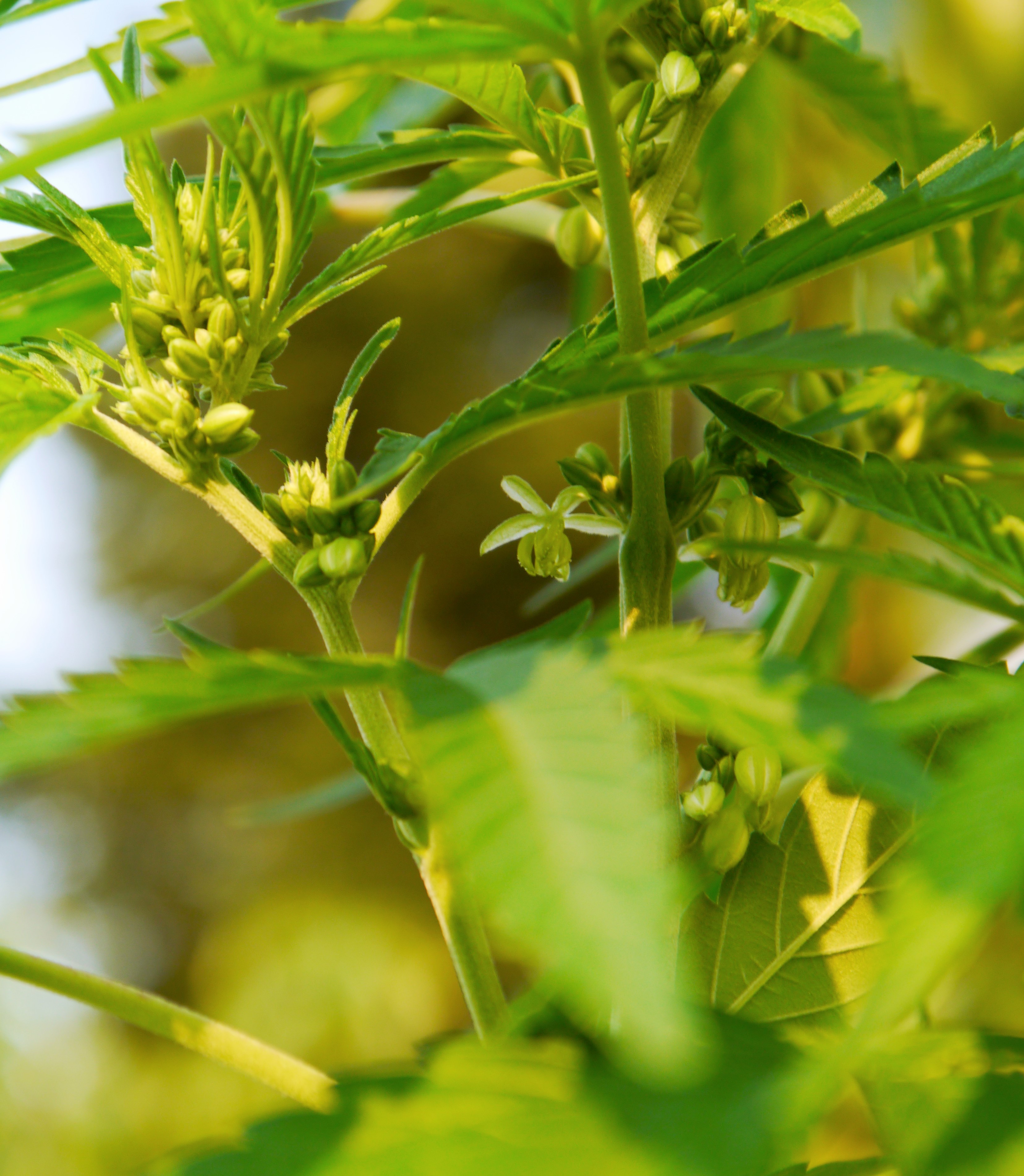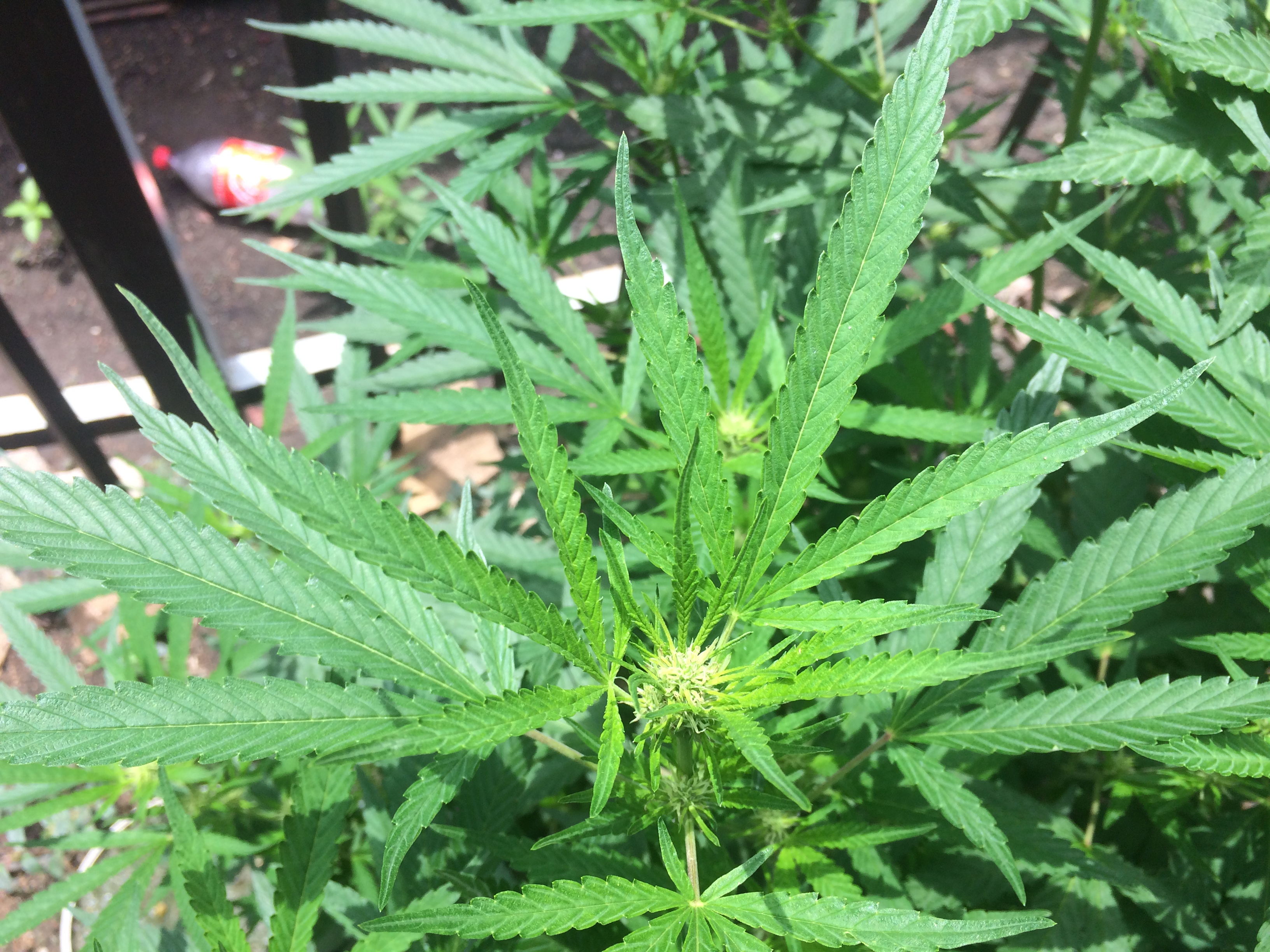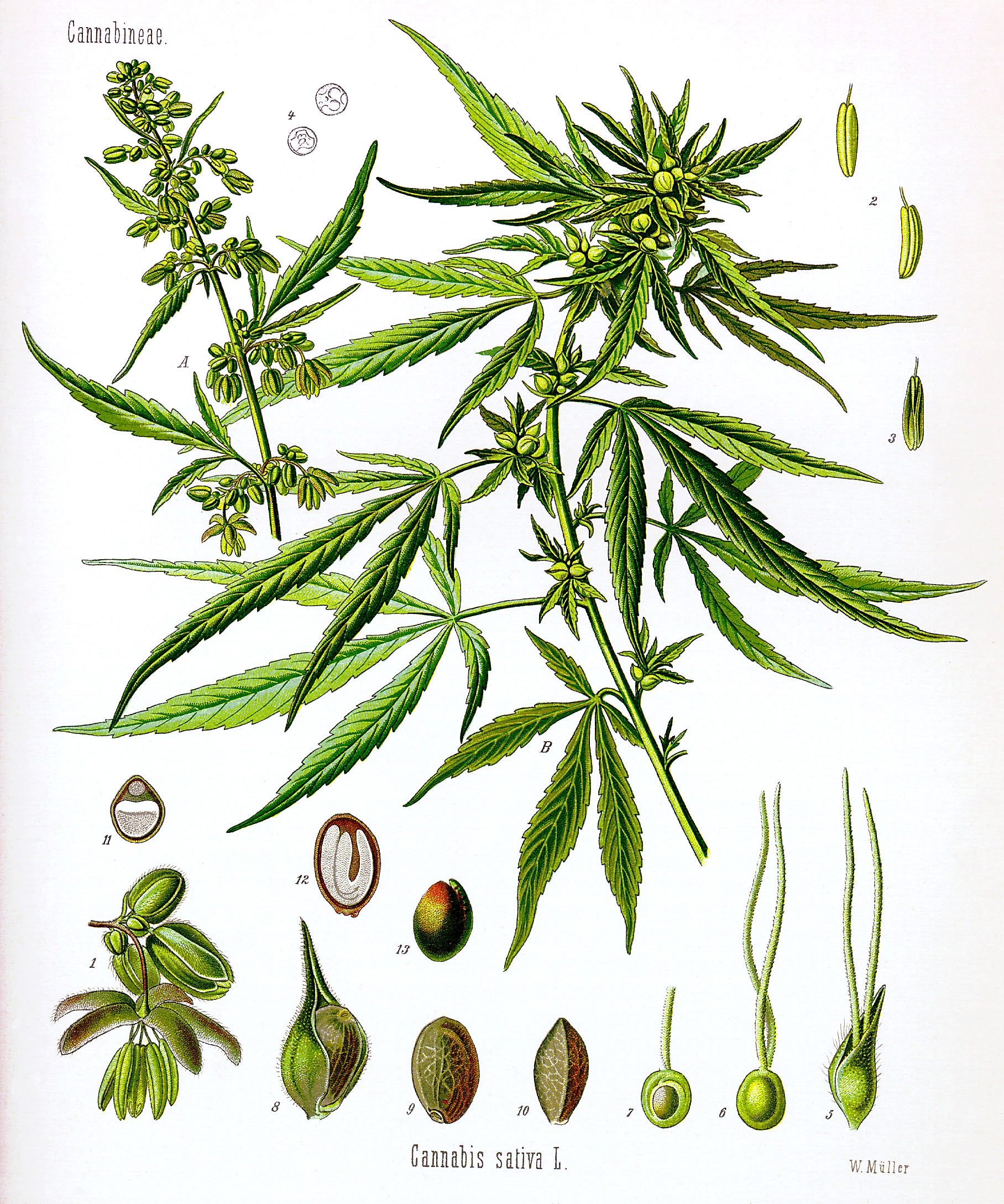Cannabis sativa on:
[Wikipedia]
[Google]
[Amazon]
 ''Cannabis sativa'' is an annual herbaceous
''Cannabis sativa'' is an annual herbaceous
 The flowers of ''Cannabis sativa'' are unisexual and plants are most often either male or female. It is a short-day flowering plant, with staminate (male) plants usually taller and less robust than pistillate (female or male) plants. The
The flowers of ''Cannabis sativa'' are unisexual and plants are most often either male or female. It is a short-day flowering plant, with staminate (male) plants usually taller and less robust than pistillate (female or male) plants. The

 Although the main psychoactive constituent of ''Cannabis'' is
Although the main psychoactive constituent of ''Cannabis'' is
 ''Cannabis sativa'' is an annual herbaceous
''Cannabis sativa'' is an annual herbaceous flowering plant
Flowering plants are plants that bear flowers and fruits, and form the clade Angiospermae (), commonly called angiosperms. The term "angiosperm" is derived from the Greek words ('container, vessel') and ('seed'), and refers to those plants t ...
indigenous to Eastern Asia
East Asia is the eastern region of Asia, which is defined in both geographical and ethno-cultural terms. The modern states of East Asia include China, Japan, Mongolia, North Korea, South Korea, and Taiwan. China, North Korea, South Korea ...
, but now of cosmopolitan distribution due to widespread cultivation. It has been cultivated throughout recorded history
Recorded history or written history describes the historical events that have been recorded in a written form or other documented communication which are subsequently evaluated by historians using the historical method. For broader world his ...
, used as a source of industrial fiber, seed oil, food
Food is any substance consumed by an organism for nutritional support. Food is usually of plant, animal, or fungal origin, and contains essential nutrients, such as carbohydrates, fats, proteins, vitamins, or minerals. The substance is in ...
, recreation
Recreation is an activity of leisure, leisure being discretionary time. The "need to do something for recreation" is an essential element of human biology and psychology. Recreational activities are often done for enjoyment, amusement, or plea ...
, religious and spiritual moods and medicine
Medicine is the science and practice of caring for a patient, managing the diagnosis, prognosis, prevention, treatment, palliation of their injury or disease, and promoting their health. Medicine encompasses a variety of health care pr ...
. Each part of the plant is harvested differently, depending on the purpose of its use. The species was first classified by Carl Linnaeus
Carl Linnaeus (; 23 May 1707 – 10 January 1778), also known after his ennoblement in 1761 as Carl von Linné Blunt (2004), p. 171. (), was a Swedish botanist, zoologist, taxonomist, and physician who formalised binomial nomenclature, ...
in 1753. The word ''sativa
Sativa, sativus, and sativum are Latin botanical adjectives meaning '' cultivated''. It is often associated botanically with plants that promote good health and used to designate certain seed-grown domestic crops.
Usage
''Sativa'' (ending in -a) ...
'' means "things that are cultivated."
Plant physiology
 The flowers of ''Cannabis sativa'' are unisexual and plants are most often either male or female. It is a short-day flowering plant, with staminate (male) plants usually taller and less robust than pistillate (female or male) plants. The
The flowers of ''Cannabis sativa'' are unisexual and plants are most often either male or female. It is a short-day flowering plant, with staminate (male) plants usually taller and less robust than pistillate (female or male) plants. The flower
A flower, sometimes known as a bloom or blossom, is the reproductive structure found in flowering plants (plants of the division Angiospermae). The biological function of a flower is to facilitate reproduction, usually by providing a mechanis ...
s of the female plant are arranged in raceme
A raceme ( or ) or racemoid is an unbranched, indeterminate type of inflorescence bearing flowers having short floral stalks along the shoots that bear the flowers. The oldest flowers grow close to the base and new flowers are produced as the s ...
s and can produce hundreds of seeds. Male plants shed their pollen and die several weeks prior to seed ripening on the female plants. Under typical conditions with a light period of 12 to 14 hours, both sexes are produced in equal numbers because of heritable X and Y chromosomes. Although genetic factors dispose a plant to become male or female, environmental factors including the diurnal light cycle can alter sexual expression. Naturally occurring monoecious plants, with both male and female parts, are either sterile or fertile; but artificially induced " hermaphrodites" can have fully functional reproductive organs. "Feminized" seed sold by many commercial seed suppliers are derived from artificially "hermaphroditic" females that lack the male gene, or by treating the plants with hormones or silver thiosulfate
Thiosulfate ( IUPAC-recommended spelling; sometimes thiosulphate in British English) is an oxyanion of sulfur with the chemical formula . Thiosulfate also refers to the compounds containing this anion, which are the salts of thiosulfuric acid, e ...
.
Pharmacology
 Although the main psychoactive constituent of ''Cannabis'' is
Although the main psychoactive constituent of ''Cannabis'' is tetrahydrocannabinol
Tetrahydrocannabinol (THC) is the principal psychoactive constituent of cannabis and one of at least 113 total cannabinoids identified on the plant. Although the chemical formula for THC (C21H30O2) describes multiple isomers, the term ''THC' ...
(THC), the plant is known to contain more than 500 compounds, among them at least 113 cannabinoids; however, most of these "minor" cannabinoids are only produced in trace amounts. Besides THC, another cannabinoid produced in high concentrations by some plants is cannabidiol (CBD), which is not psychoactive but has recently been shown to block the effect of THC in the nervous system. Differences in the chemical composition of ''Cannabis'' varieties may produce different effects in humans. Synthetic THC, called dronabinol, does not contain cannabidiol (CBD), cannabinol
Cannabinol (CBN) is a mildly psychoactive cannabinoid that acts as a low affinity partial agonist at both CB1 and CB2 receptors. This activity at CB1 and CB2 receptors constitutes interaction of CBN with the endocannabinoid system (ECS).
CBN w ...
(CBN), or other cannabinoids, which is one reason why its pharmacological effects may differ significantly from those of natural ''Cannabis'' preparations.
Chemical constituents
Beside cannabinoids, the chemical constituents of ''Cannabis'' include about 120 compounds responsible for its characteristic aroma. These are mainly volatileterpene
Terpenes () are a class of natural products consisting of compounds with the formula (C5H8)n for n > 1. Comprising more than 30,000 compounds, these unsaturated hydrocarbons are produced predominantly by plants, particularly conifers. Terpenes ...
s and sesquiterpene
Sesquiterpenes are a class of terpenes that consist of three isoprene units and often have the molecular formula C15H24. Like monoterpenes, sesquiterpenes may be cyclic or contain rings, including many unique combinations. Biochemical modific ...
s.
* α- Pinene
* Myrcene
Myrcene, or β-myrcene, is a monoterpene. A colorless oil, it occurs widely in essential oils. It is produced mainly semi-synthetically from ''Myrcia'', from which it gets its name. It is an intermediate in the production of several fragrances. � ...
* Linalool
Linalool () refers to two enantiomers of a naturally occurring terpene alcohol found in many flowers and spice plants. Linalool has multiple commercial applications, the majority of which are based on its pleasant scent (floral, with a touch of ...
* Limonene
* Trans-β- ocimene
* α- Terpinolene
* Trans- caryophyllene
* α- Humulene, contributes to the characteristic aroma of ''Cannabis sativa''
* Caryophyllene, with which some hashish detection dogs are trained
Cannabis also produces numerous volatile sulfur compounds that contribute to the plant's skunk-like aroma, with Prenylthiol (3-methyl-2-butene-1-thiol) identified as the primary odorant. These compounds are found in much lower concentrations than the major terpenes and sesquiterpenes. However, they contribute significantly to the pungent aroma of cannabis due to their low odor thresholds as often seen with thiol
In organic chemistry, a thiol (; ), or thiol derivative, is any organosulfur compound of the form , where R represents an alkyl or other organic substituent. The functional group itself is referred to as either a thiol group or a sulfhydryl gro ...
s or other sulfur-containing compounds.
Common uses
''Cannabis sativa'' seeds are chiefly used to make hempseed oil which can be used for cooking, lamps, lacquers, or paints. They can also be used as caged-bird feed, as they provide a source of nutrients for most animals. The flowers and fruits (and to a lesser extent the leaves, stems, and seeds) contain psychoactivechemical compound
A chemical compound is a chemical substance composed of many identical molecules (or molecular entities) containing atoms from more than one chemical element held together by chemical bonds. A molecule consisting of atoms of only one element ...
s known as cannabinoids
Cannabinoids () are several structural classes of compounds found in the cannabis plant primarily and most animal organisms (although insects lack such receptors) or as synthetic compounds. The most notable cannabinoid is the phytocannabinoid tet ...
that are consumed for recreational, medicinal, and spiritual purposes. When so used, preparations of flowers and fruits (called marijuana) and leaves and preparations derived from resinous extract (e.g., hashish
Hashish ( ar, حشيش, ()), also known as hash, "dry herb, hay" is a drug made by compressing and processing parts of the cannabis plant, typically focusing on flowering buds (female flowers) containing the most trichomes. European Monitoring ...
) are consumed by smoking, vaporising, and oral ingestion. Historically, tincture
A tincture is typically an extract of plant or animal material dissolved in ethanol (ethyl alcohol). Solvent concentrations of 25–60% are common, but may run as high as 90%.Groot Handboek Geneeskrachtige Planten by Geert Verhelst In chemistr ...
s, teas, and ointments have also been common preparations. In traditional medicine
Traditional medicine (also known as indigenous medicine or folk medicine) comprises medical aspects of traditional knowledge that developed over generations within the folk beliefs of various societies, including indigenous peoples, before the ...
of India in particular ''Cannabis sativa'' has been used as hallucinogenic, hypnotic, sedative
A sedative or tranquilliser is a substance that induces sedation by reducing irritability or excitement. They are CNS depressants and interact with brain activity causing its deceleration. Various kinds of sedatives can be distinguished, but ...
, analgesic, and anti-inflammatory agent. Terpenes have gained public awareness through the growth and education of medical and recreational cannabis. Organizations and companies operating in cannabis markets have pushed education and marketing of terpenes in their products as a way to differentiate taste and effects of cannabis. The entourage effect, which describes the synergy of cannabinoids, terpenes, and other plant compounds, has also helped further awareness and demand for terpenes in cannabis products.
Cultivation
A ''Cannabis'' plant in the vegetative growth phase of its life requires more than 16–18 hours of light per day to stay vegetative. Flowering usually occurs when darkness equals at least 12 hours per day. The flowering cycle can last anywhere between seven and fifteen weeks, depending on the strain and environmental conditions. When the production of psychoactivecannabinoids
Cannabinoids () are several structural classes of compounds found in the cannabis plant primarily and most animal organisms (although insects lack such receptors) or as synthetic compounds. The most notable cannabinoid is the phytocannabinoid tet ...
is sought, female plants are grown separately from male plants to induce parthenocarpy
In botany and horticulture, parthenocarpy is the natural or artificially induced production of fruit without fertilisation of ovules, which makes the fruit seedless. Stenospermocarpy may also produce apparently seedless fruit, but the seeds ar ...
in the female plant's fruits (popularly called "sin semilla" which is Spanish for "without seed" ) and increase the production of cannabinoid-rich resin.
In soil, the optimum pH for the plant is 6.3 to 6.8. In hydroponic growing, the nutrient solution is best at 5.2 to 5.8, making ''Cannabis'' well-suited to hydroponics because this pH range is hostile to most bacteria and fungi.
Tissue culture
Tissue culture is the growth of tissues or cells in an artificial medium separate from the parent organism. This technique is also called micropropagation. This is typically facilitated via use of a liquid, semi-solid, or solid growth medium, su ...
multiplication has become important in producing medically important clones, while seed production remains the generally preferred means of multiplication. Sativa plants have narrow leaves and grow best in warm environments. They do, however, take longer to flower than their Indica counterparts, and they grow taller than the Indica cannabis strains as well.
Cultivars
Broadly, there are three main cultivar groups of cannabis that are cultivated today: * Cultivars primarily cultivated for their fibre, characterized by long stems and little branching. * Cultivars grown for seed which can be eaten entirely raw or from whichhemp oil
Hemp oil (hemp seed oil) is oil obtained by pressing hemp seeds. Cold pressed, unrefined hemp oil is dark to clear light green in color, with a nutty flavor. The darker the color, the grassier the flavour. It should not be confused with hash oi ...
is extracted.
* Cultivars grown for medicinal or recreational
Recreation is an activity of leisure, leisure being discretionary time. The "need to do something for recreation" is an essential element of human biology and psychology. Recreational activities are often done for enjoyment, amusement, or pleas ...
purposes, characterized by extensive branching to maximize the number of flowers.
A nominal if not legal distinction is often made between industrial hemp, with concentrations of psychoactive compounds far too low to be useful for that purpose, and marijuana.
See also
* '' Cannabis indica'' * '' Cannabis ruderalis'' *Cannabis strains
''Cannabis'' strains are either pure or hybrid varieties of the plant genus ''Cannabis'', which encompasses the species '' C. sativa'', '' C. indica'', and '' C. ruderalis''.
Varieties are developed to intensify specific characteristics of th ...
* Difference between ''C. indica'' and ''C. sativa''
References
External links
* {{Authority control Cannabis strains Crops originating from Asia Entheogens Euphoriants Flora of Central Asia Hemp Medicinal plants of Asia Phytoremediation plants Plants described in 1753 Plants used in traditional Chinese medicine Taxa named by Carl Linnaeus